Average Speed of Answer (ASA) of calls: How do you track it?

VP of Customer Experience
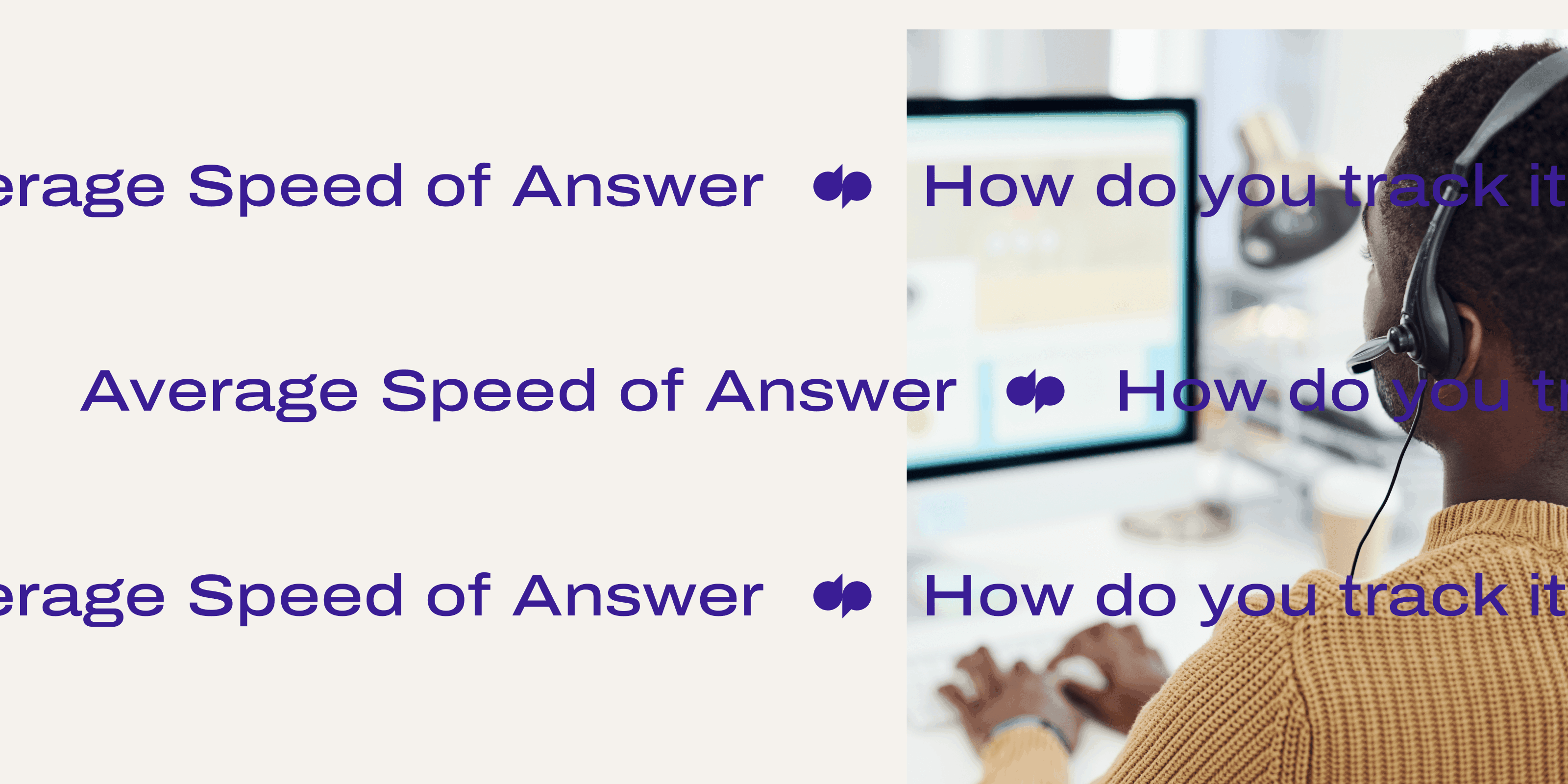
Tags
Share
If you’re like me, there have been times when you deliberately missed a call.
Telemarketers—that’s a big one.
Missing personal calls is all well and good as there are usually no real repercussions (sorry, Auntie Jean)—but when it comes to business calls, a missed call can mean lost opportunities or a disgruntled customer.
ASA (average speed of answer) is one of the key call center metrics to look at if you're a contact center supervisor or customer support lead.
But what exactly is it? And how can you improve it to also improve customer satisfaction in your contact center?
What is the average speed of answer (ASA)?
Basically, ASA is how quickly a customer support agent can answer an inbound call, starting from the point the caller is placed in any queue.
It excludes any wait time spent routing that caller to the correct queue, and it also excludes any time the customer spends interacting with your IVR (interactive voice response) menu. But it does include the time during which an agent’s phone is ringing and also contributes to average handle time.
Why it matters to call centers
If you lead customer support in a contact center, you have to track and monitor multiple key performance indicators (as well as looking to improve those figures). And one thing to focus on is ASA.
Even though ASA isn’t the same thing as other KPIs like average handling time (AHT) and CSAT, they are related and it’s important to look at these together instead of in a vacuum.
For example, I'd want my agents to find the fastest path possible to resolving issues and answering questions. I'd also want any customer who calls us to go away satisfied—both with any answers and with their overall customer experience.
A low ASA is good because it generally means your agents are answering calls as quickly as possible, dealing with issues efficiently, and not leaving a customer waiting.
A good ASA also reflects well on your IVR or ACD (automatic call distributor) system. If you’re using IVR menus to manage and deflect calls, you’ll have set it up to guide the caller through different options.
So how can you tell if your IVR is effective at helping route the caller to the customer service representative best equipped to help them? How do you know if you’ve got the right menu options?
This is generally simple to do because we use Dialpad AI Contact Center’s analytics to see stats on our IVR menus. We can see usage counts for each option on the menu, and how these counts compare to each other:
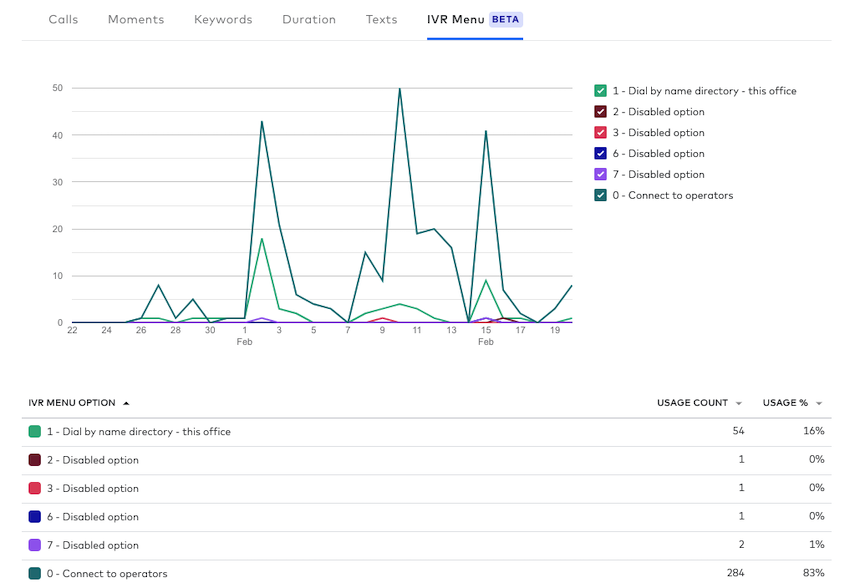
If we see that there’s an IVR option that no one has used in months, then that’s a sign that we can probably remove it and streamline the options for our callers so they don’t have to sit there listening to so many options.
👉Dialpad tip:
If your business gets a lot of calls and you’re not using IVR now, you should really look into it. It lightens the load on your agents and allows your callers to direct themselves to the right place.
Understanding the average speed of answer formula
If math isn’t your favorite thing in the world, but you still have to deal with several calculations on our KPIs, then you’ll be happy to know that this formula is fairly simple.
Just take the total waiting time for calls that were answered and divide it by the total number of answered calls.
For example:
Let’s say last week, my team answered 5,000 calls. The total time in a queue for those calls was 200,000 seconds. So for that week, my team’s ASA was 40 seconds.
(That doesn’t mean every call got answered in 40 seconds. This is just the average amount of time and there will always be outliers!)
Is it better to have an extremely short ASA?
To know if your ASA is good is a bit tricky because it depends on a number of factors. If you have an extremely low ASA, that might seem like a good thing at first—but it could also be a sign that you’re overstaffed. (You may think that increasing staff to reduce ASA would be a good thing—but how much more are you spending per ticket? What’s an acceptable amount?)
If we have an overly high ASA and call center agents are taking too long to answer, then there’s a good chance that a customer will get annoyed, hang up, and add to our abandonment rates. That’s not good for them—or us.
This is why Dialpad is useful. We can easily access all the analytics we need, and look at how the ASA fluctuates throughout the day or week for my department:
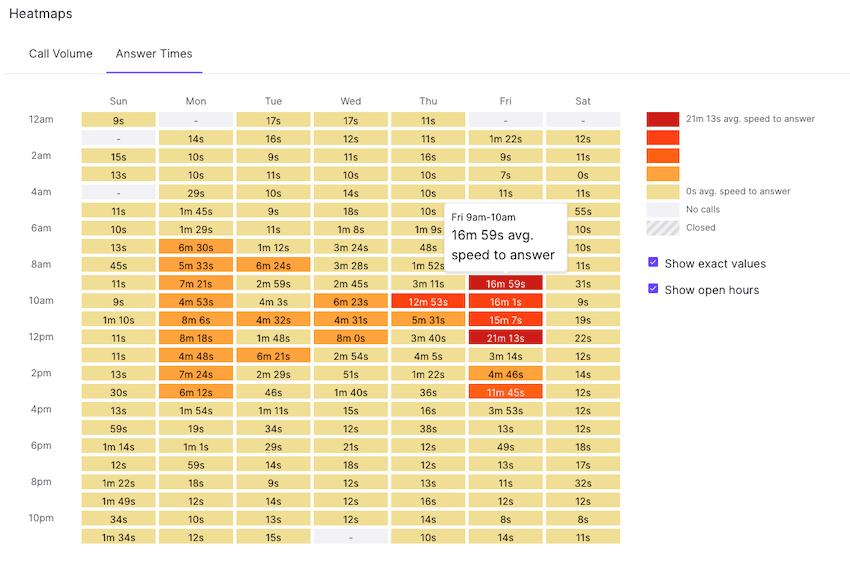
Right now, we’re aiming for a benchmark ASA of under one minute. (And we’re hitting our service levels!) And that’s only possible if you can easily access analytics like this. It makes it so much easier to spot problems before they come up and quickly address them. Your ASA is going to depend on a few factors, from how many staff you have (or can afford) to how long it takes a query to be answered. If you find your ASA is high, then consider some of the solutions in the following section.
✨ Want to improve your contact center's performance?
Grab the Contact Center Playbook, which breaks down everything you need to know, from setup to improving customer satisfaction—with examples from real contact center teams across different industries.
How to optimize your call center’s ASA
Let’s imagine for a minute that you’re looking at your call center’s analytics. Most of the figures are looking good—but you have noticed that your ASA is a lot higher than you would like.
How can you address that issue and optimize it? Here are a few ideas.
1. Use an in-queue call back
We don’t like having our customers facing long waits in queues. But there are times when our team is overwhelmed by the volume of calls.
That’s where the in-queue call back option in Dialpad comes in handy:
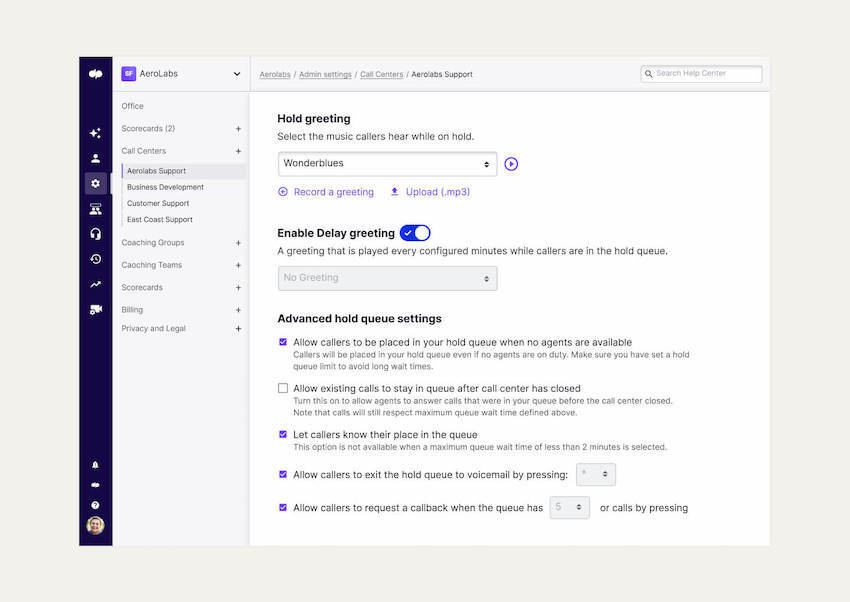
This way, after a set amount of time, the caller can opt to receive an outbound call back from the agent when their ticket reaches the front of the queue. They can be called back on the number they called from or can input an alternative number.
Much better than waiting on the line and listening to Celine Dion on loop for eternity.
2. Investigate your call forecasting
Forecasting the call volume to your call center is actually much easier today than it was, even a few years ago. (I showed you Dialpad’s heat map for ASA earlier, but there’s another heatmap in Dialpad that you can look at for call volumes!)
This is a crucial aspect when you’re planning. Knowing, or at least having a rough idea, of how many incoming calls you may receive at different times of the day/week/month means you can plan staffing levels to fit.
For example, if you notice that you receive twice the number of calls on weekends than weekdays, it makes sense to raise staffing levels to meet demand.
👉Dialpad tip:
Make a habit of comparing your historical call forecast with the actual figures to see if they’re accurate. You have to do this regularly to make sure your forecasts stay accurate. If not, and if there is a pattern of deviation, then adjust your future forecasts to fit with any differences.
3. Take advantage of your call routing system
I find call routing to be one of the most useful tools around for contact centers.
Ideally, you’ll have a variety of routing options. How you use call routing will depend on a number of factors, from operating hours to call volumes. If you can combine it with an effective IVR menu, it’s a great one-two punch for keeping customers happy.
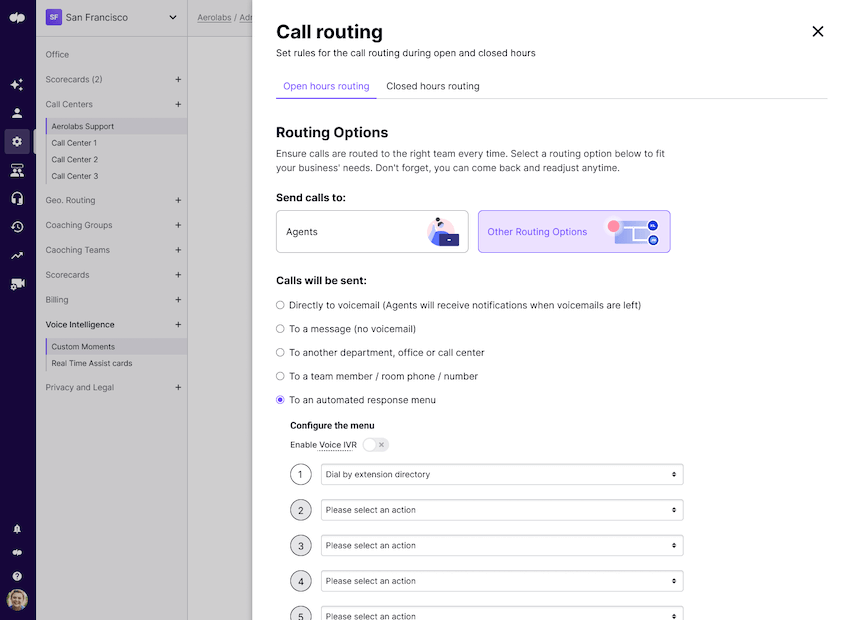
👉Dialpad tip:
Again, it’s helpful to analyze your historical data here. It gives you a good idea of how to configure your routing, and while you can never predict 100% what your needs will be, there will be patterns that can help you get a good idea of what to do.
4. Train (and retrain) agents as needed
One thing I always tell new call center agents is that once their initial training is finished, their real training begins.
We operate in a sector that constantly sees new tech arriving and old tech evolving. But we also learn from everything we do each day—and from things that happen within the call center industry as a whole.
We’re always updating our training materials and again, here’s where Dialpad really helps our team.
It’s pretty much impossible to train every single agent individually—at Dialpad we have quite a few contact center departments!—but you can use Dialpad’s Real-time Assist (RTA) cards to automate this part of training.
For example, if you find that certain topics are tripping up my agents, you can create an RTA card to pop up automatically on their screens with tips on how to answer those questions—when certain keywords are spoken on a call:
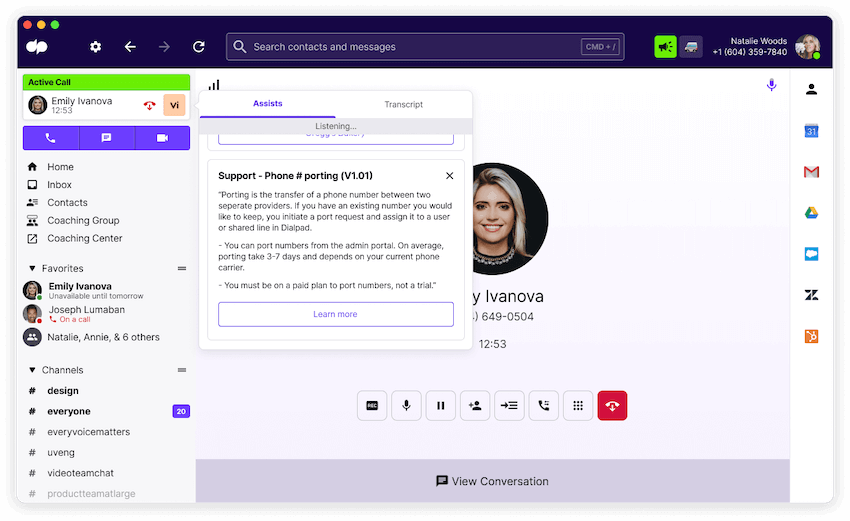
This way, you can make sure your team is still learning and being coached on new info—but do it at scale.
5. Give agents access to real-time analytics
It’s often said that you are your own biggest critic. And with some agents, this is very true!
Often, it’s nearly always the agent who ends up identifying any issues with their performance or figures.
By allowing your agents to see analytics in real time (as you can with Dialpad), you’re empowering them to see what’s working and what may need a little change in their approach:
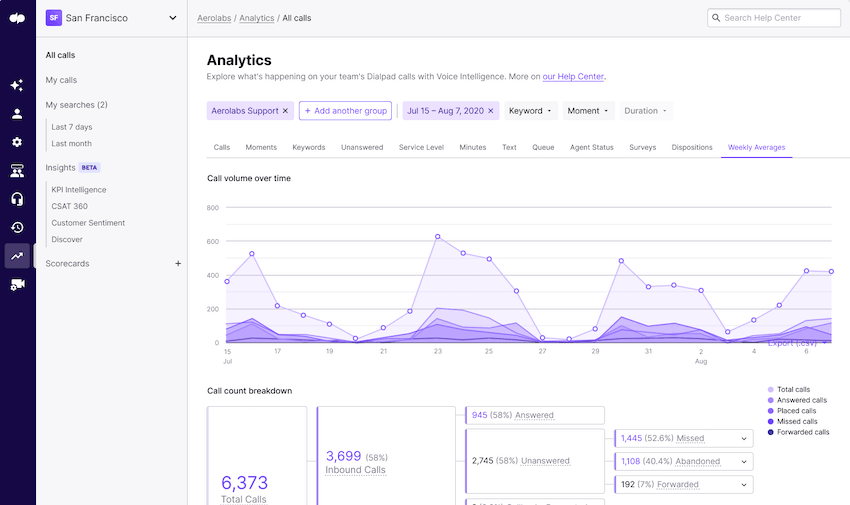
Don’t overlook the accessibility of your data. It’s often helpful for not just you, but your agents too.
6. Reward agents who go beyond the benchmarks
While, of course, our primary focus is on making sure that customers are happy with their experience or journey, we also want to make sure our teams are engaged and happy at their work.
If they’re happy, then they’re more likely to provide a good experience. A little (friendly) competition is sometimes also helpful for morale and motivation (depending on your team’s personalities, of course).
Although verbal praise and recognition are things you should practice with your staff, incentivizing their performance is not only helpful, but can be fun too.
It’s amazing what a little competition between individual call center agents (or teams) can do to help focus them on the main KPIs (such as ASA)—see if you can provide prizes like time off or gift cards.
👉Dialpad tip:
Incentives don’t need to cost your organization a lot of money! For some, it’s more about taking part and the fun of competing. A team building day where teams compete against each other can be a lot of fun!
Reduce your call center’s ASA with the best strategies and tools
For some folks who first start working in a contact center, it’s tempting to think that all the job entails is answering phones and replying to queries.
Today, we have multiple workforce management strategies and ways to optimize every area of call center performance. We have various software packages (such as CRM) and automation to help manage the workforce, analyze performances, and almost everything else needed (except make a cup of coffee just the way I like it, but I think even that will be doable one day).
Want to improve your contact center's average speed of answer (and other metrics)?
Dialpad Support is designed to help you (and your agents) improve your customer experience. Book a product tour to see how it works!
